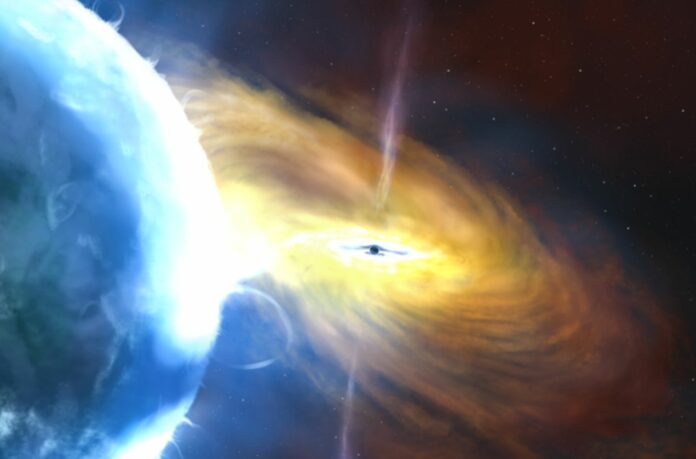Recent observations of Cygnus X-1, a black hole with the mass of a star, have given researchers valuable learning about how the very hot matter near the black hole is arranged.
As the matter is pulled toward a black hole, it heats up to a million degrees. In X-rays, this heated stuff glows. Measurements of the polarization of these X-rays are being used by scientists to test and improve theories that explain how black holes consume matter to become some of the most brilliant sources of light, including X-rays, in the universe.
The Imaging X-Ray Polarimetry Explorer (IXPE) project, a joint venture between NASA and the Italian Space Agency, made its first observations of a mass-accreting black hole with the latest results from Cygnus X-1, which were published in the journal Science today. One of our galaxy’s strongest X-ray sources is Cygnus X-1, which consists of a companion star with a mass of 41 solar masses around a black hole with a mass of 21 solar masses.
“Previous X-ray observations of black holes only measured the arrival direction, arrival time, and energy of the X-rays from hot plasma spiraling toward the black holes,” highlights lead author Henric Krawczynski.
“IXPE also measures their linear polarization, which carries information about how the X-rays were emitted — and if, and where, they scatter off material close to the black hole.”
Inside a black hole’s event horizon, no light can escape, not even X-ray light. The X-rays recorded by IXPE are generated by heated matter or plasma in a region with a diameter of 2,000 kilometers encircling the event horizon of a black hole with a diameter of 60 kilometers.
When the IXPE data was combined with observations made at the same time by NASA’s NICER and NuSTAR X-ray observatories in May and June 2022, the authors were able to figure out the geometry of the plasma, that is its shape and location.
Researchers discovered that the plasma flows in the opposite direction of a two-sided, pencil-shaped jet of plasma seen in earlier radio observations. The idea that the events in the X-ray bright region nearby the black hole play a major role in launching the jet is strongly supported by the alignment of the direction of the X-ray polarization and the jet.
The data is consistent with predictions that state the disk of matter spiraling into the black hole is either sandwiched by the corona of hot plasma or is completely replaced by it. Based on the new polarization data, models in which the black hole’s corona is a thin column or cone of plasma along the jet axis can no longer be true.
Scientists said that a better understanding of how the shape of the plasma around a black hole works can tell us a lot about how black holes work and how they gather matter.
“These new insights will enable improved X-ray studies of how gravity curves space and time close to black holes,” Krawczynski adds.
According to co-author Michal Doviak from the Astronomical Institute of the Czech Academy of Sciences, “IXPE observations reveal that the accretion flow is seen more edge-on than previously thought” in relation to the Cygnus X-1 black hole especially.
“This may be a signature of a misalignment of the equatorial plane of the black hole and the orbital plane of the binary,” or the paired duo of the black hole and its companion star, adds co-author Alexandra Veledina from the University of Turku. “The system may have acquired that misalignment when the black hole progenitor star exploded.”
“The IXPE mission uses X-ray mirrors fabricated at NASA’s Marshall Space Flight Center and focal plane instrumentation provided by a collaboration of ASI, the National Institute for Astrophysics (INAF) and the National Institute for Nuclear Physics,” adds co-author Fabio Muleri of INAF-IAPS. “Beyond Cygnus X-1, IXPE is being used to study a wide range of extreme X-ray sources, including mass accreting neutron stars, pulsars and pulsar wind nebulae, supernova remnants, our galactic center and active galactic nuclei. We’ve found a lot of surprises, and we’re having a lot of fun.”
A second paper in the same issue of Science details the IXPE detection of highly polarized X-rays from the magnetar 4U 0142+61 under the direction of Roberto Taverna at the University of Padova.
“We are thrilled to be part of this new wave of scientific discovery in astrophysics,” adds Krawczynski.
Source: 10.1126/science.add5399
Image Credit: John Paice
